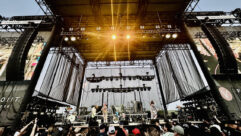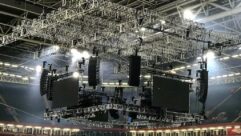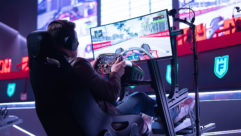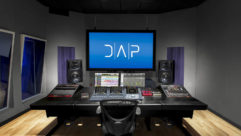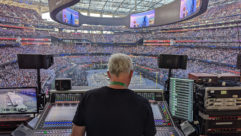
Installation Profile:
Setting the Stage
Oct 1, 2006 12:00 PM,
By Charles Conte
AV makes the Kennedy Center’s Family Theater a versatile performance space.
Web Exclusive
Family Theater: Interactive Mode
Constructed over an 11-month period with federal funds, the Kennedy Center’s Family Theater is part of the facility’s five-year, $125 million effort to upgrade arts education. Opened late last year, it is the first new self-contained theater to be created at the Kennedy Center in 26 years.

Close collaboration in the design of the Kennedy Center’s new 14,000-square-foot Family Theater led to well-thought-out equipment placements to make the best use of the space—including a small-footprint Yamaha PM5D digital console.
The new 14,000-square-foot theater, home to the Kennedy Center’s Education Department, was essentially carved out of the large, upstage scene boxes of the existing Eisenhower Theater, in a space that formerly housed the American Film Institute Theater. In addition to more than 250 theater, music, dance, and storytelling performances and events for young people and their families annually, the 324-seat theater offers a broad range of programming and events. For instance, a permanently installed video projection system using a Christie LX1000 projector with a wired remote has been integrated into the auditorium for Microsoft PowerPoint and DVD playback. This allows the new theater to be used for meetings and conferences, among other applications. Tied into the Kennedy Center’s infrastructure, the Family Theater also functions as a distance-learning center and a source for television broadcast and webcast events.
Architects for the Kennedy Center Family Theater were Richter Cornbrooks Gribble (RCG). JaffeHolden Acoustics provided acoustic and systems design.
“Working with the Kennedy Center, we helped develop a building-wide infrastructure,” says JaffeHolden systems designer Russ Cooper. “The goal for the Kennedy Center, including the Family Theater, was to connect the building to loading docks for broadcast or recording of any event. In addition, the Family Theater is a distance-learning venue, both for broadcast and receiving, with multiple camera positions across the room and a projection system that you wouldn’t normally expect to find in a theater venue.”
PLANNING FOR THE FUTURE
The renovated Kennedy Center Opera House was the first performance space in the center to receive fiber-optic and Cat-5 cabling. Similarly, the design for the Family Theater is built on a full video, fiber, and Cat-5 copper backbone. Installers ran 8 miles of conduit to create an infrastructure for lighting, audio, video, and data for the theater. The project focus was on serving the facility’s interconnectivity needs for the next 30 years.
As production audio technician John Burke puts it, “You can always buy a console, or speakers, or amplifiers. But you only get one pass at putting pipe in the walls. … Don’t abandon your copper, but data transfer is the future. No doubt about that.”
FITTING IN
The challenge of designing an AV system for the Family Theater was to fit it into the context of the Kennedy Center as a whole.
“There’s an established standard for operations at the Kennedy Center,” Cooper says. “All the spaces try to share equipment and spare parts. Dealing with legacy systems is part of the challenge. For example, many of their fan-outs are on a multi-connector that we no longer specify, but because this is the standard for the rest of the building, we use them. The Kennedy Center has a large and very knowledgeable staff, so we give careful consideration to their input based on how they operate. As a consequence, the amount of collaboration between us and the Kennedy Center was much larger here than it is on other projects.”
Glenn Turner, head of the Kennedy Center’s production operations shop, adds, “The systems do everything that the technicians need them to do.” This is possible because the center’s technical staff had so much input — a spreadsheet of specific needs, really — into the infrastructure design, and the Family Theater into which it fits.
During this process, the theater production staff’s close collaboration with the systems designer helped bridge the creative world of the theater and the installation and construction worlds.
“In the world of the theater, we’re all focused on a common goal — we have a curtain at 8 o’clock,” says Turner. “Everybody pulls together to get the show up and running. But, in contracting and construction, there’s always the potential for change-orders, and if it’s not in the documentation originally, you can’t get creative after the fact. The relationship with JaffeHolden has worked out very well for us.”
That collaboration led to well-thought-out equipment decisions. For example, the Family Theater FOH equipment is based around a Yamaha PM5D digital console and JBL loudspeakers, powered by Crown I-tech amplifiers.

The designers applied sound absorption, reflection, and diffusion surfaces to minimize the acoustic volume in the room, and create a kid-friendly acoustic space.
“[The operations staff members] like the functionality and the recall [of the Yamaha PM5D] — the ability to store shows and bring them back if they need to,” Cooper says.
JBL loudspeakers are a standard throughout the Kennedy Center performance spaces, and the PM5D’s small footprint (with 48 XLR inputs) was critical in the limited space of the Family Theater.
“Essentially, we were putting a full, legitimate theater inside a 40’×100′ shell,” Turner explains. “These were absolute constraints. We couldn’t make the room 5ft. wider to accommodate ducts and conduits. The white marble outer walls of the Kennedy Center weren’t going anywhere.”
Squeezing equipment into the space was a challenge.
“We were forced to come up with some unique solutions for storing equipment,” Cooper says. The amp room ended up encasing an elevator lobby, for instance. “Formerly, the elevator doors opened into the theater. Now they open directly into the amp room, which accesses the control booth. … We solved an ADA [Americans with Disabilities Act] issue at the same time we solved an equipment storage issue.” The only previous access to the control booth was by stairs. Now a disabled technician can access the booth by elevator.
MAKING IT MODULAR
With 3,000 performances and special events in 10 performance spaces originating from the Kennedy Center each year, audio and video equipment gets a workout.
“We try to keep everything as modular as we can,” Turner says. “If we have a piece go down, we have central place we can go to for spares. For that reason, we stay within certain families of gear.
“The Family Theater is such a small space that we didn’t have room for a lot of outboard gear, so we tried to minimize everything. This was our main reason for choosing the Yamaha digital console and the Crown I-tech amplifiers. The I-techs are smart amps. You can build EQs into them, and that technology helped us save space. Of course, this presents another issue: modernizing our other theaters just to catch up, and staying modular when we do, so we can have plug-and-play replacements.”
SPACE FOR YOUNG PEOPLE
Creating a successful acoustic space for young theatergoers has all the inherent challenges of creating one for mature audiences, and more. It’s certainly not kiddie stuff.
“Young listeners have trouble focusing, as anyone who has children knows,” says Mark Holden, JaffeHolden’s acoustic designer and company principal. “They need all the help they can get. … They have to be able to hear clearly in order to understand what’s happening on stage. The acoustic space has to create contact and intimacy with the performers in order to capture children’s attention.”
JaffeHolden’s acoustic design and systems design for the Family Theater, therefore, aims at grabbing kids’ attention and holding it. Acoustically speaking, loud is not the answer in such a situation.
“Children are all too often spoon-fed audio at pretty high levels,” Holden says. “They’re rusty at the skill of attentive listening. … Maximizing speech intelligibility, giving them a clear understanding, is critical to captivating a young audience.”
CRAFTING THE CONCEPT

Glenn Turner, head of the Kennedy Center’s production operations shop.
The overall design concept for the Family Theater was very much a collaborative effort among theater and lighting designer Roger Morgan (of Sachs Morgan Studio), architect Jonathan Fishman (of Richter Cornbrooks Gribble), and JaffeHolden systems designers.
Holden says, “One way to summarize the architectural, theatrical, and acoustic goals of designing the Family Theater is maximizing speech from the stage, in a room at full capacity of potentially noisy people.
“We wanted to create a dry environment — one that was clear and articulate, but not overly supportive of the audience area. The idea is to control the way sound moves in the room, absorbing and attenuating the sound that comes from the kids in the audience, so it’s not accentuated.”
Accomplishing this is a matter of keeping the acoustic volume in the room down to a minimum by distributing and placing acoustic sound absorption, reflection, and diffusion surfaces in such a way that everything supports the mission of getting and keeping children completely involved in the theatrical experience.
“Everyone in programming and production is very happy with the space,” Burke says. “This was not an easy job — dealing with the extremely limited space that the architect and JaffeHolden had to work with. But they are a first-rate team, including the construction company, Whiting- Turner Contracting, and their project managers. … The building did not close while construction was going on, and performances continued at the Eisenhower. If we had a construction team less attentive to our concerns, this job could have been awful.”
USING THE ROOM
“There’s no such thing as a small show anymore,” adds Burke. Shows developed at the Family Theater travel all over the country. Developing technical specifications for each of these productions takes into account that they may play to houses with four or five times the seating capacity of the Family Theater, and with stages much larger than the Family Theater’s 32ft.-wide stage.
Robert Humphrey is the sound designer for Family Theater productions developed inhouse, and is also responsible for the technical setup of touring productions. Humphrey has worked at the Kennedy Center for six years, starting out as technical director and sound engineer for touring shows. His experience, he says, allows him to see what will work and what will not. Taking down and putting up a show in three-hour periods has to work.
Before the Family Theater space was completed, setup for young people’s shows took place in the Theater Lab, a flexible playing space that has been home to the center’s production of Shear Madness for 18 years. Humphrey conducted technical setup in this space for incoming touring shows, as well.
Now, all technical setup takes place in the Family Theater. Outside shows come with their own technical requirements. In such cases, Humphrey says, he functions more like a live sound engineer. For that reason, although it can easily be brought into the control booth, the Yamaha PM5D remains on the house floor.
However, the challenge of Humphrey’s job remains, at least in part, teching shows for larger houses. Begun in 1992, The Imagination Celebration Tour brings high-quality family productions to communities around the country. Many of these Youth and Family productions are specifically commissioned by the Kennedy Center. Once the pieces are fully mounted in the Family Theater, they are prepared to go on the road with four to seven performers and two to four technicians with elaborate lighting and sets.
“The Family Theater is one of the smallest stages our shows would play in,” says Humphrey. “Teching a show for touring, you have to consider sight lines and stage depth, and stage width to make sure the hosting theater has enough curtain to frame out the borders.”
The Family Theater may be the smallest performance space of the 10 total spaces at the Kennedy Center, but it is doing big things, and its reach far exceeds the family-friendly confines of the theater itself.
FAMILY THEATER: INTERACTIVE MODE
The Kennedy Center broadcasts just about every day of the year, via TV and the Web, from its multiple performance venues. But only one of these performance venues allows for interactive participation by viewers off-site: the Family Theater, through the Performing Arts Series.
In cooperation with the Prince William Network, the Kennedy Center offers arts-based educational programming free to teachers and students across the country. Students can phone in, fax, and email questions for the artists appearing on stage. Questions are solicited during live broadcasts onscreen via an 800 number and an email address. The artists read email questions on a stage-facing monitor. (Faxed and emailed questions are taken both prior to and after each broadcast as well.) There are two permanently mounted cameras in the Family Theater, in addition to a front-of-house camera. For interactive broadcasts, other cameras are brought into the theater to capture questions from the floor.
During the 12 months following an original live broadcast, programs can be rebroadcast as often as needed. An archive of past programs is available online as well, in addition to study guides, instructional activities, and other program resources.
The major performance groups at the Kennedy have their own educational programs. The National Symphony Orchestra (NSO), which broadcasts regularly from the Concert Hall, and has its own Young People’s Concert Series. But for interactive presentations, the orchestra uses the Family Theater. About one-quarter of the interactive events in the theater involve the NSO.
For More Information
Christie
www.christiedigital.com
Crown
www.crownaudio.com
dbx
www.dbx.com
Fujitsu
www.fujitsu.com
Videotek
www.broadcast.harris.com/videotek
Yamaha
www.yamahaca.com
Charles Conteis a marketing communications consultant, writer, and president of Big Media Circus. He can be reached at[email protected].


